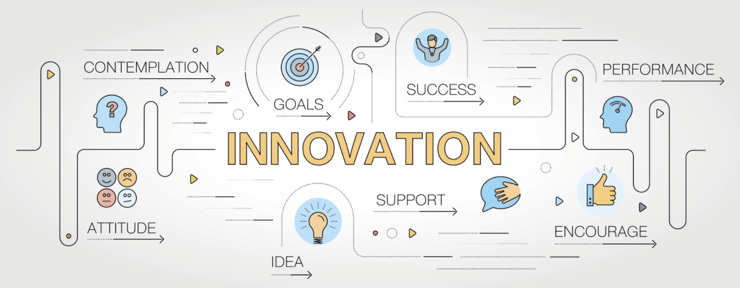










































 To create a culture of innovation, you must first shift focus. The best starting point is to look for what’s working.
To create a culture of innovation, you must first shift focus. The best starting point is to look for what’s working.For most organizations, a default position is to tackle the immediate problems (often called “firefighting”).
Managers get so busy putting out “fires” (tackling immediate problems) that it is difficult to see beyond. It is difficult to shift focus and this environment also makes it difficult to innovate.
Managers are all too familiar with this mode of operation.
What if instead, however, there was a different focus? How different would operations and consequently, culture be?
Consider this study of US and European companies conducted by the Boston Consulting Group. It found that, "over the past 15 years, a number of procedures, vertical layers, interface structures, coordination bodies, and decision approvals... has increased by anywhere from 50 percent to 350 percent."
Add to this that, "managers spend 40 percent of their time writing reports and 30 percent to 60 percent of it in coordination meetings" and we can soon start to get a picture of organizational focal points.
Well firstly we can recognize that for most managers, there is a daily deluge of problems with few solutions. To overcome these, organizations often turn to the tried and true: technical remedies to ‘fix and change’.
Why?
It’s what we know that works. The ‘tried and true’ is perhaps, contrary to ‘innovation’.
Let’s take for example, 3M, a company well-known for its innovative culture, to illustrate this.
3M employed Six Sigma as a strategic enabler when the then-new CEO, James McNerney, came on board in 2001 from GE. He cut costs. He had thousands of employees trained in Six Sigma. He demanded rigorous process metrics (including those from the Research & Development (R&D) department).
Yes, 3M cut expenses and improved efficiencies during James McNerney’s tenure until 2005.
But at significant cost.
New product (those products that didn’t exist three years earlier) revenue typically sat around 30%. Throughout McNerney’s time at the helm, revenue from new products fell to 21%. Efficiencies were made (improving margins by some 17%) but at the detriment of innovative new products.
Another organisation enthusiastically implementing Six Sigma was Home Depot.
A Businessweek article put its demise bluntly: "Profitability soared, but worker morale dropped, and so did consumer sentiment. Home Depot fell from first to last among major retailers on the American Customer Satisfaction Index in 2005."

What does all this mean?
Simply, in a rapidly changing and evolving business world, the ’fix and change‘ way of thinking will hold you back. Opportunities can be missed.
Nothing is ever perfect and never will be. There will never be a perfect time. We always have one more problem in finance or production, or IT that are staring us in the face.
But when externally-driven change is upon us, we need to be able to adapt our focus.
And quickly, if we are to survive.
This can be an amazing simple strategy of shifting focus a little and looking for the small but important successes. These catalysts can create momentum and therefore, opportunity.
We do need to think about the best practices that are all around us in our organizations and we also need to think of the little wins that are peeking out from under the deluge.
EXCLUSIVE VIDEO: Debunking Myths: How Operational Excellence Fosters Innovation and Agility, Ebay
Marsh & McLennan
Consider Marsh & McLennan, a global professional services business. They’ve been around for more than a century, and as such, have had to overcome industry, global, customer, regulatory and other environmental changes.
The triumph of such challenges gave birth to innovation where new goals and targets were set.
Marsh employed Ben Allen as Chief Information Officer (CIO) and Chief Innovation officer.
One of the first things he did was to shift focus away from immediate problems to, instead, internal best practice.
Why?
By setting up collaborative platforms within Marsh & McLennan’s operating companies, Allen fostered an approach to find out what was working first. Then build on those. By sharing these initiatives, the organizational communication process provided a gateway for other departments to try the ideas and avoid pitfalls.
Like so many organizations, the innovations that arose from overcoming such challenges were serendipitous in response to extreme situations. Marsh & McLennan set a goal to innovate in a more proactive and systematic fashion right across their business units, instead of deploying a reactive problem-solving approach.

Ben Allen’s strategy was to teach the organization to look for what is already working. This showed that, despite Marsh & McLennan being a “traditional” business, its people were innovative and contributed immensely to improving the organization.
The first thing Allen did to build this process was capitalize on the capabilities their people already had. Marsh & McLennan had disciplined research abilities to identify unmet customer needs. They combined this with collaborative platforms across their operating companies and with customers to generate insights.
They also developed a learning and coaching program, which built on the good work the product and service delivery teams were already doing to foster innovation. By building on what worked and then connecting these processes across the group, Allen enabled Marsh & McLennan to dramatically improve its innovation capabilities.
To focus on improvement and innovation is tough. We see problems everywhere. That’s why to progress change, we need to be clear on the vision — lead in the future state direction, show people how to get there, how to act, and what destination to pursue. And that’s why looking for best practices already held is so important: These chart the course.
Some organizations, like Apple, are forced to change by dint of the industry they are in but other, like banks or insurance companies (such as Marsh & McLennan), have less impetus.
It’s all about solving problems first, even if the organization is struggling with complexity and a barrage of compliance and regulations. This is why looking for internal innovation best practice is so important. It shows people, just like you, what to do in a bite-sized, digestible format.
Change Management: Uncover a Masterpiece by Changing Just One Thing
Problem solving isn't the opposite of innovation and it isn't necessarily mutually exclusive. After McNerney’s departure in 2005 for Boeing, 3M still kept Six Sigma as a tool to improve manufacturing efficiencies but left it out of the rest of the organization.
Instead, they instituted once again, a significant innovation program. They set up small, cross-functional teams that moved away from existing departments to network and collaborate on new projects across the organization. Each new contact offered a new opportunity to redefine important attributes on future market demand and/or innovative approaches.
3M went on to create a safe environment, which allowed:
In 2010, 3M’s sales percentage from new products was back at 30% and growing.
Imagine if your organization systematically looked for, and disseminated best practices? What would this mean?
Imagine if an organization wasn’t focused on ‘firefighting’ and crisis but opportunities and growth.
Where would it be now?
To create opportunity in times of change, we need to shift our focus.
Building an organizational-wide, innovative focus requires systems and processes built up around finding and exploiting the unique opportunity already in place. Otherwise, when the day-to-day operational whirlwind begins, focus is immediately removed. Why would you want to comprise focus when it can be a unique differentiator?
Consider this: In your business, what’s the ratio of time spent exploiting successes versus solving problems?
Author Bio:
Daniel Lock helps organizations unlock value and productivity through process improvement, project and change management. Find out more about him at daniellock.com and download a free eBook on Fundamentals of Change Management where you’ll learn not only the fundamentals of change management but why these are critical to achieve business outcomes. Make change work for you and add to your tools and techniques.
Social Media Links:
LinkedIn - https://www.linkedin.com/in/daniellock/
Twitter - https://twitter.com/daniellock
View our schedule of industry leading free to attend virtual conferences. Each a premier gathering of industry thought leaders and experts sharing key solutions to current challenges.
View Schedule of EventsWelcome to BTOES Insights, the content portal for Business Transformation & Operational Excellence opinions, reports & news.
------------------------------
-------------------------------------------------------
Search for anything
Insights from the most progressive thought leaders delivered to your inbox.
Insights from the world's foremost thought leaders delivered to your inbox.
Being a hero is all about creating value for others. Please invite up to 5 people in your network to attend this premier virtual conference, and they will receive an invitation to attend.
If it’s easier for you, please enter your email address below, and click the button, and we will send you the invitation email that you can forward to relevant people in your network.
View our schedule of industry leading free to attend virtual conferences. Each a premier gathering of industry thought leaders and experts sharing key solutions to current challenges.
View Schedule of EventsWatch On-Demand Recording - Access all sessions from progressive thought leaders free of charge from our industry leading virtual conferences.
Watch On-Demand Recordings For FreeDelivered by the industry's most progressive thought leaders from the world's top brands. Start learning today!
View All Courses NowThe premier Business Transformation & Operational Excellence Conference. Watch sessions on-demand for free. Use code: BFH1120
Watch On-DemandInsights from the most progressive thought leaders delivered to your inbox.
Insights from the world's foremost thought leaders delivered to your inbox.
Being a hero is all about creating value for others. Please invite up to 5 people in your network to also access our newsletter. They will receive an invitation and an option to subscribe.
If it’s easier for you, please enter your email address below, and click the button, and we will send you the invitation email that you can forward to relevant people in your network.
Courtesy of Nintex Pty's Paul Hsu, below is a transcript of his speaking session on 'Improve employee productivity during and post-COVID by ...
Read this article about HP, Best Achievement in Operational Excellence to deliver Digital Transformation, selected by the independent judging panel, ...
Read this article about BMO Financial Group, one of our finalists, in the category Best Achievement in Operational Excellence to deliver Digital ...
Read this article about Cisco, one of our finalists, in the category Best Achievement of Operational Excellence in Internet, Education, Media & ...









































































































































































































